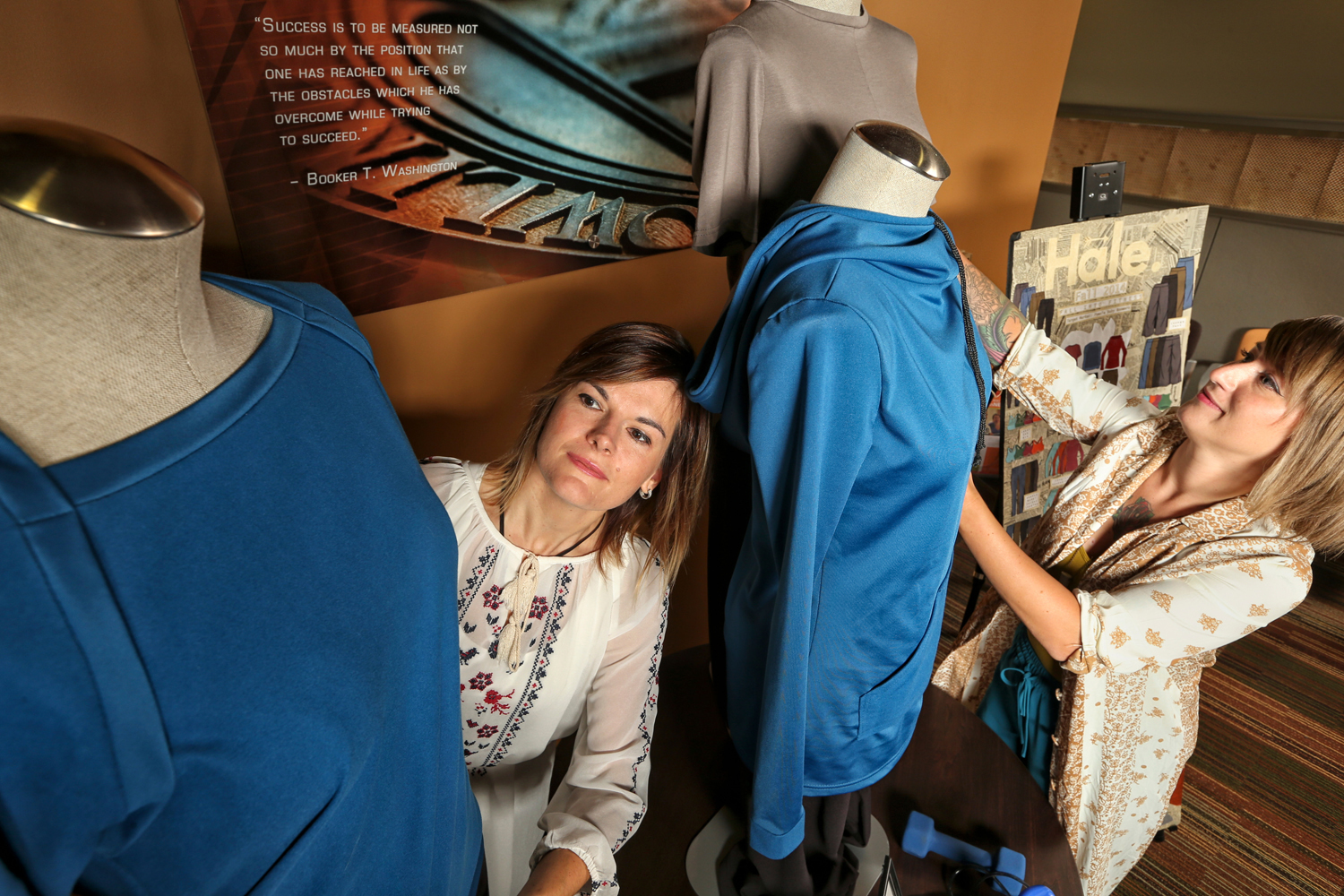
This summer, a display case in the Bowling Green State University Education Building contained several
women’s active-wear garments – a hooded sweatshirt, pants, two shirts, plus the "inspiration
board" of their designer, recent graduate Ashlee Layman.
The story of the clothes’ journey from Bulgaria to BGSU is a tale of student and faculty creativity,
resourcefulness and willingness to try something new.
As Layman approached the final semester of her Apparel Merchandising and Product Development degree
program, she was itching for a challenge. A nontraditional student who had returned to complete her
undergraduate degree after four years away from BGSU, she felt the need to take her learning to the next
level instead of merely completing her last few credits.
She found her challenge and more when her mentor, Mariana Mitova, a lecturer in the AMPD program,
suggested that Layman do an independent study in collaboration with the Dimitar Talev Technical School
in Mitova’s hometown of Gotse Delchev, Bulgaria. Layman jumped at the chance, even though Mitova warned
her she really couldn’t predict how the first-time venture would turn out.
"It’s an award-winning school and its students had won national design competitions in
Bulgaria," Mitova said. She’d been exploring possibilities with Elena Ivanova, a teacher there,
about collaborating, and finally they’d hit upon the idea of an independent study. "The goal was to
have a product line from concept to drawing to finished garments. So we were testing the water to see
how much effort it would take to create a successful exchange."
It did take a lot of effort all around, the participants learned. The Bulgarians actually had to keep the
school open at night at times for Skype meetings with Layman and Mitova.
"They’re seven hours different from us," Mitova said, "but the administration was very
enthusiastic about the project. This was the first opportunity for them to work with a school in another
country."
The plan was for Layman to design a series of garments aimed at baby boomer women, for which the students
in the Bulgarian school would create the patterns. A local Bulgarian company agreed to donate the
fabric, and the Bulgarian students would sew the clothing. Layman and Mitova would be responsible for
inspecting the finished pieces for quality.
"Ashlee was very open to the idea of working on this with me," Mitova said. "She was
nervous about it initially, but it turned out to be a great project. She had taken classes with me
before last spring and I could see myself working with her."
"There were some speed bumps, but it was definitely interesting, and totally worth it," Layman
reflected. Along the way, she said, she learned many valuable lessons about working with an
international partner.
"I’d taken our Global Issues in Apparel and Textiles class, which was a very challenging class, but
I still didn’t have a real idea about how difficult it can be to work with partners in another
country."
Having that experience, though, paid off in her job search. Layman has been hired as assistant manager
for the apparel department at an Anthropologie store being built in Columbus. The upscale retail chain
specializes in merchandise reflecting global influences.
"They were impressed when they heard about my experience," Layman said.
During the Bulgarian project, because of the language difference Mitova had to serve as translator, an
aspect that was a bit frustrating for Layman.
"I did some research on the country and the culture so I would know more what to expect, but to
actually deal with them firsthand was different," Layman said. "There were a lot of things I
was surprised about. I learned not to be offended if it took them a week to email back. We’re all so
rushed and organized and prompt here, but there things go at a different pace."
Sometimes it was the speed of the pace that surprised the Americans.
"I had taken the pattern-making class, so I could have done that part, but that is their specialty
and so it gave them a chance to work on it," Layman said. "We sent them the spec sheets with
all the details like how many buttons and zippers there should be, and how many stitches."
To Mitova’s and her amazement, the students sent back the patterns within just three days, and they were
perfect, Layman said.
Then came the more difficult part, actually sewing the garments.
Adjustments had to be made because the donated fabric was not ideal for athletic wear and the Bulgarian
school did not have certain machines, which meant the way the garments were constructed had to be
changed.
That necessitated more conversation between Layman and the Bulgarian students.
And when without warning, the garments finally arrived, "Honestly, the quality was amazing,"
she said appreciatively. "I’ve never seen such well-made clothes, especially for athletic wear.
Every seam and stitch was perfect. And these were girls in high school."

